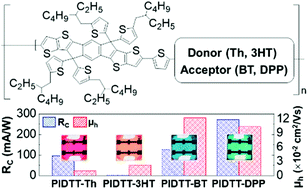Synthesis of indacenodithienothiophene-based conjugated polymers containing electron-donating/accepting comonomers and their phototransistor characteristics†
Abstract
Here we report the synthesis of conjugated polymers based on an indacenodithienothiophene (IDTT) unit (a seven-membered heterocycle) and their photosensing characteristics in a geometry of organic field-effect transistors (OFETs). Four different comonomers (two electron-donating and two electron-accepting units) were employed for the synthesis of IDTT-based conjugated polymers in order to investigate their influence on the thermal, optical, electronic, and photosensing properties. The OFETs with the IDTT-based polymer channel layers were fabricated with a device structure of bottom gate-top source/drain electrodes. Results showed that the IDTT-based polymers with the electron-accepting comonomers were more thermally stable than those with the electron-donating comonomers. The electron-accepting comonomers delivered relatively deep-lying highest occupied molecular orbital (HOMO) energy levels, while they extended the optical absorption range (edge) up to ca. 900 nm. The IDTT-based polymers with the electron-accepting comonomers showed about ten-times higher hole mobility and more than two-times higher photoresponsivity than those with the electron-donating comonomers.



 Please wait while we load your content...
Please wait while we load your content...